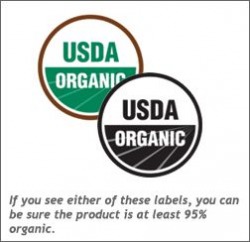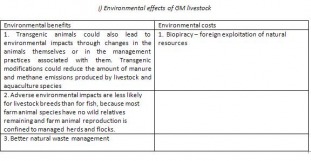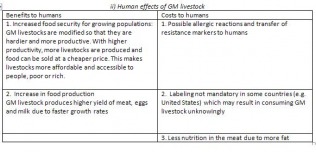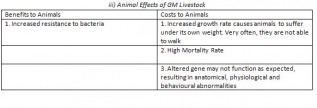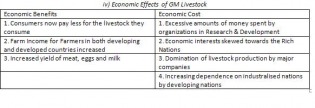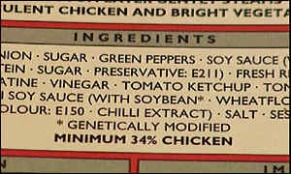TWC G6 Livestock Production
Types of Livestock : Organic Vs GM
Organic Livestock
Definition of Organic Livestock
Organic animals are produced without genetically modified organisms or ionizing radiation. These animals that produce meat, poultry, eggs, and dairy products do not take antibiotics or growth hormones.
Source : http://organic.org
Definition of Organic Livestock
Organic animals are produced without genetically modified organisms or ionizing radiation. These animals that produce meat, poultry, eggs, and dairy products do not take antibiotics or growth hormones.
Source : http://organic.org
Benefits of organic livestock
i) Financial rewards for farmers
This is achieved by decreasing operating costs. Sustainable practices help maintain lower levels of expenditure for expensive farm equipment and chemicals such as pesticides and herbicides. Labour costs can also be decreased substantially.
Farmers who are not feeding their livestock antibiotics or using hormones to stimulate growth are able to sell their products to the growing organic food market which pays a higher premium. Many organic farmers are reporting an increase in profitability of up to 20 percent.
ii) Environmental benefits
The aim of sustainable, organic farming is to optimize land as well as animal and plant interactions while at the same time preserving the natural nutrient and energy flows. Land that is certified organic must be free of fertilizer and pesticides for at least the last three years, among other requirements. Organic ranging also improves the biodiversity of the farmland and reduces soil erosion which in turn reduces property loss.
iii) Healthy food for the consumers
Aside from the obvious lack of extra hormones and antibiotics, grass-fed beef is one-third to three times leaner than grain-fed beef, and as a consequence has fewer calories; a 6-ounce beef loin from a grass-fed cow can have 92 fewer calories than a 6-ounce loin from a grain-fed cow. Grass-fed beef also contains more beta carotene, vitamin E and folic acid, which are important antioxidants that protect us from free radicals, boost our immunity and can help to lower the risk of heart disease.
iv) Improvement in quality of life for farmers
Farmers who use organic practices also describe how their own quality of life has improved not only through their relationship with their animals and their land but also with their family members and coworkers. Sustainable operation on the farm means careful forethought and planning ahead. This entails full group participation and cooperation affording a lot of satisfaction to be gained from a positive team effort. Furthermore, because sustainable methods often reduce certain levels of management, hay production for example, farmers often have more time to spend with their families.
i) Financial rewards for farmers
This is achieved by decreasing operating costs. Sustainable practices help maintain lower levels of expenditure for expensive farm equipment and chemicals such as pesticides and herbicides. Labour costs can also be decreased substantially.
Farmers who are not feeding their livestock antibiotics or using hormones to stimulate growth are able to sell their products to the growing organic food market which pays a higher premium. Many organic farmers are reporting an increase in profitability of up to 20 percent.
ii) Environmental benefits
The aim of sustainable, organic farming is to optimize land as well as animal and plant interactions while at the same time preserving the natural nutrient and energy flows. Land that is certified organic must be free of fertilizer and pesticides for at least the last three years, among other requirements. Organic ranging also improves the biodiversity of the farmland and reduces soil erosion which in turn reduces property loss.
iii) Healthy food for the consumers
Aside from the obvious lack of extra hormones and antibiotics, grass-fed beef is one-third to three times leaner than grain-fed beef, and as a consequence has fewer calories; a 6-ounce beef loin from a grass-fed cow can have 92 fewer calories than a 6-ounce loin from a grain-fed cow. Grass-fed beef also contains more beta carotene, vitamin E and folic acid, which are important antioxidants that protect us from free radicals, boost our immunity and can help to lower the risk of heart disease.
iv) Improvement in quality of life for farmers
Farmers who use organic practices also describe how their own quality of life has improved not only through their relationship with their animals and their land but also with their family members and coworkers. Sustainable operation on the farm means careful forethought and planning ahead. This entails full group participation and cooperation affording a lot of satisfaction to be gained from a positive team effort. Furthermore, because sustainable methods often reduce certain levels of management, hay production for example, farmers often have more time to spend with their families.
Source : http://www.organicproducermag.com/index.cfm?fuseaction=feature.display&feature_id=25
Regulations of organic livestock
The USDA (United States Department of Agriculture) National Organic Program defines organic as follows:
Organic meat, poultry, eggs, and dairy products come from animals that are given no antibiotics or growth hormones… a product can be labeled "organic," a Government-approved certifier inspects the farm where the food is grown to make sure the farmer is following all the rules necessary to meet USDA organic standards…
Source : http://organic.org
The USDA (United States Department of Agriculture) National Organic Program defines organic as follows:
Organic meat, poultry, eggs, and dairy products come from animals that are given no antibiotics or growth hormones… a product can be labeled "organic," a Government-approved certifier inspects the farm where the food is grown to make sure the farmer is following all the rules necessary to meet USDA organic standards…
Source : http://organic.org
GM Livestock
Definition of GM livestock
A livestock that has acquired one or more genes by artificial means.
Definition of transgenic livestock (under GM livestock)
Transgenic animal is a subset of GM livestock. Transgenic animal is one that carries a foreign gene that has been deliberately inserted into its genome.
Effects of GM livestock
Genetic engineering/modification of animals has much to offer to humans as long as we are aware of the potential benefits and side effects.
Environmental Effects due to GM livestock
Source : http://www.greenfacts.org/en/gmo/3-genetically-engineered-food/6-genetically-modified-animal.htm#1p0
Effects on humans due to GM livestock
Effects on livestock due to GM
Economic Effects due to GM livestock
Sources : http://www.ornl.gov/sci/techresources/Human_Genome/elsi/gmfood.shtml
http://www.geneticallymodifiedfoods.co.uk/economic-impact-gm-foods.html
Regulations of GM livestock
Additional Information about the Regulations of GM livestock can be found at US Food & Drug Administration (FDA)
Source : http://www.fda.gov/AnimalVeterinary/DevelopmentApprovalProcess/GeneticEngineering/GeneticallyEngineeredAnimals/default.htm
Source : http://www.fda.gov/AnimalVeterinary/DevelopmentApprovalProcess/GeneticEngineering/GeneticallyEngineeredAnimals/default.htm
